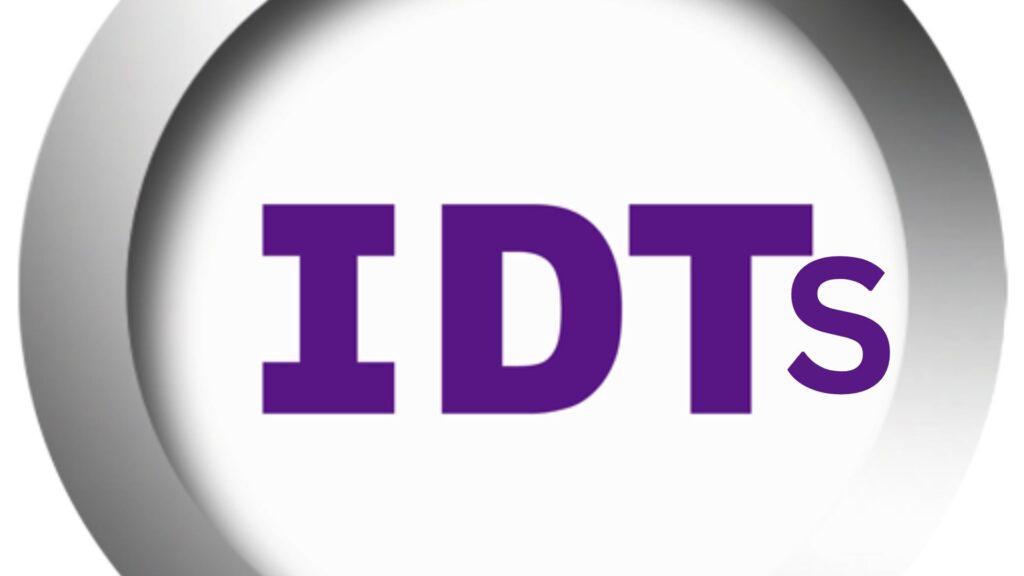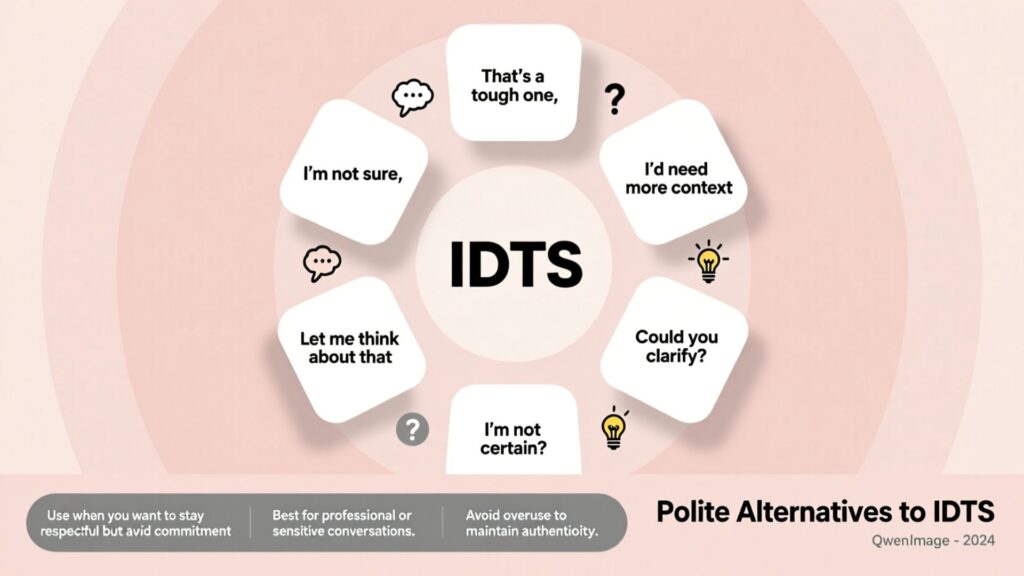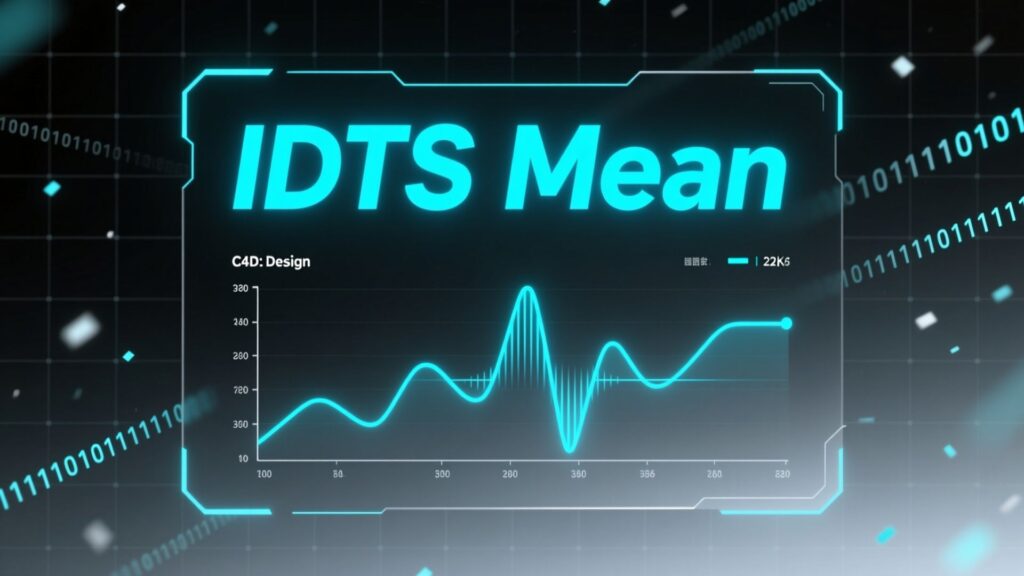If you’ve ever seen IDTS flick across a text or chat and wondered what it meant and whether it’s rude you’re not alone. In this guide, you’ll discover the idts full form in chat, true idts meaning in chat, how tone shifts its interpretation, and which polite alternatives serve you better in different settings.
Introduction: Why This Matters in 2025

Digital conversation has become our default mode texts, DMs, Slack messages, social media comments. In that fast world, one mis-step in tone or abbreviation can change meaning entirely.
Take a simple exchange:
“Want to meet at 6?”
“IDTS.”
Does that read as a quick no, passive-aggressive dismissal, or just uncertainty?
As communication increasingly lacks vocal tone and body language, what we say and how we say it matters all the more. That’s why understanding acronyms like IDTS and choosing better alternatives will help you stay clear, polite, and effective.
In this article you’ll learn:
- The idts meaning and idts full form in chat
- Real examples of usage and how tone changes meaning
- When “idts” is fine and when it’s risky
- A rich list of professional, friendly, and diplomatic alternatives
- How to choose the right wording based on audience, medium, and situation
- Predictions for digital communication trends in 2025
Let’s dive in.
What Does “IDTS” Mean in Text?
At its root, IDTS stands for “I don’t think so.” (Dictionary.com) Many online dictionaries and slang repositories confirm that it’s a shorthand used to express doubt, skepticism, or disagreement. (Slanginfo.com)
Let’s break it down:
- I → “I”
- Don’t → contraction of “do not”
- Think → “believe, consider, expect”
- So → “in that way, yes, that assertion”
Put together, “I don’t think so” communicates you believe something is unlikely or incorrect.
Origins & Evolution
- It emerged in texting and chat culture as a compressive phrase just like LOL, BRB, or IDK.
- As people typed faster and sought brevity, “I don’t think so” shrunk into IDTS.
- Over time, it became part of internet slang lexicons. (Slanginfo.com)
- Some early chat abbreviation lists (e.g. in older chat guides) already list IDTS = I don’t think so. (Diocese of Madison)
So when someone uses IDTS, they are typically signaling disagreement, disbelief, or uncertainty more succinctly than writing out the full phrase.
Context and Real-World Usage
Knowing what IDTS means isn’t enough. You also must see how it behaves in real conversation. Context shifts tone dramatically.
Here are some real-life uses and how they land.
Usage Examples per Scenario
| Scenario | Chat Example | Tone / Interpretation |
|---|---|---|
| Casual banter with friend | “IDTS, that movie was overrated” | Light disagreement |
| Responding to rumor | “They say she got the job.” – “IDTS.” | Doubt, skeptical tone |
| Gaming chat or argument | “You won’t beat me.” – “IDTS.” | Sharp disagreement, possibly hostile |
| Suggestion in group chat | “Should we go tonight?” – “IDTS, I’m tired” | Soft decline |
| Workplace Slack (informal) | “Do we need to redo this?” – “IDTS, looks fine to me” | Mild skepticism but still collegial |
These highlight how IDTS meaning shifts based on medium, punctuation, and relationship.
Tone Variations & Punctuation
- IDTS. (with a period) feels blunt or conclusive.
- IDTS? adds uncertainty.
- IDTS… softens the blow, suggests you’re thinking.
- Lowercase “idts” often softens tone further.
- Add an emoji or qualifier: “IDTS 😅” or “IDTS, but I might be wrong.”
Because text lacks vocal cues, small signals like punctuation and extra words can reshape meaning.
Is “IDTS” Rude or Too Casual?
Using IDTS isn’t inherently rude but it can come off that way in certain contexts. Whether it lands politely or abrasively depends on:
- Your relationship with the receiver
- The medium (text, Slack, email, social media)
- The subject and stakes
- Accompanying tone cues (emoji, follow-up, wording)
When “IDTS” feels fine
- Among close friends who know your style
- In playful arguments
- On social media or casual group chats
- When the subject is low-stakes
When “IDTS” can backfire
- In professional/business communication
- With someone you don’t know well
- When tension or emotion is already high
- When the topic is sensitive
Case Study
Suppose you message your manager:
“Do you want me to redo sections A and B?”
“IDTS.”
That could seem dismissive or uncooperative especially lacking context. Even if you mean “I don’t think those need redoing,” it could be read as “I refuse.” Better would be: “I don’t think that’s necessary shall I double-check?”
In short: IDTS works best when both parties share the same conversational norms. If in doubt, choose clarity over compression.
Why You Might Want Alternatives
“IDTS” is short, but that brevity comes at a cost. These drawbacks show why it’s worth knowing alternatives.
Risks of sticking with IDTS
- Misinterpretation: Without vocal tone, people may read skepticism as hostility.
- Too informal: Can undermine your credibility in more serious or professional exchanges.
- Lacks nuance: “IDTS” is a blunt disagreement; you may want an option that sounds more diplomatic, uncertain, or exploratory.
- Generational or cultural divide: Not everyone knows or appreciates such abbreviations.
What better alternatives do
- Add warmth or softness
- Let you qualify your stance (“I could be wrong”)
- Fit the level of formality you want
- Show respect while disagreeing
In short, alternatives help you express the same idea “I don’t think so” but in a tone and style that better suits your audience.
Polite Alternatives to “IDTS” (with Usage Tips)

Below are 20 better alternatives to IDTS, each with example contexts and guidance. Pick the one that matches tone, audience, and relationship.
(I include 20 to give you flexibility; you can choose fewer.)
Polite and Professional Alternatives
- “I’m not sure that’s correct.”
- Use when checking facts in work or group settings.
- “I’m not sure that’s correct—shall I verify?”
- “That might not be accurate.”
- Slightly more tentative.
- “That might not be accurate—do you have a source?”
- “I see it differently.”
- Diplomatic, suggests alternate view.
- “I see it differently—here’s my take.”
- “I’d like to double-check that.”
- Softens the disagreement by inviting further review.
- “I’d like to double-check that before we commit.”
- “I don’t believe that’s right.”
- More direct, but still measured.
- “I don’t believe that’s right can we revisit it?”
- “I’m not entirely certain.”
- Expresses humility.
- “I’m not entirely certain, but my sense is…”
- “That’s not how I understand it.”
- Gentle approach to difference of view.
- “That’s not how I understand it perhaps we have different sources.”
- “I could be mistaken, but…”
- Self-deprecating cushion.
- “I could be mistaken, but I think the deadline is next week.”
- “It doesn’t seem likely.”
- Expresses doubt without total rejection.
- “It doesn’t seem likely, based on what we know.”
- “I’m inclined to disagree.”
- Firm but not harsh.
- “I’m inclined to disagree with that conclusion.”
Casual or Friendly Alternatives
- “I don’t think so, haha.”
- Lightens the tone for friends.
- “I don’t think so, haha sounds risky.”
- “Hmm, not really.”
- Soft and conversational.
- “Hmm, not really. Let me see if there’s another option.”
- “I’m not convinced, lol.”
- Informal banter.
- “I’m not convinced, lol care to show evidence?”
- “That’s not what I heard.”
- Offers alternate input.
- “That’s not what I heard maybe there’s new info.”
- “I doubt it.”
- Direct but common.
- “I doubt it will happen, but maybe we’re wrong.”
Soft, Diplomatic Phrases
- “That’s one way to see it.”
- Opens up to multiple views.
- “That’s one way to see it I see another perspective.”
- “Interesting point, but I think differently.”
- Validates their idea while pushing your own.
- “Interesting point, but I think differently based on the data.”
- “You might be right, though I see it another way.”
- Acknowledges possibility of being wrong.
- “You might be right, though I see it another way.”
- “I get your point, though I’m not sure I agree.”
- Empathetic yet honest.
- “I get your point, though I’m not sure I agree entirely.”
- “I’d lean toward a different view.”
- Indicates preference without ruling theirs out.
- “I’d lean toward a different view, especially given the new numbers.”
Choosing the Right Alternative: Context, Audience & Medium
Selecting the right phrase depends on three major factors:
- Audience – friend, colleague, boss, client
- Tone – playful, neutral, professional
- Medium – text, email, Slack, forum
Here’s a quick comparison table:
| Context | Phrase Example | Why It Works |
|---|---|---|
| Work email / formal setting | “I’d like to double-check that.” | Respectful, opens door to re-evaluate |
| Slack with teammates | “I see it differently.” | Balanced tone, not aggressive |
| Chat with friend | “I don’t think so, haha.” | Friendly, casual, playful |
| Disagreement in discussion | “You might be right, though I see it another way.” | Validates + expresses own view |
Tips:
- When talking to someone new or in authority, lean toward more polite/diplomatic phrases.
- Avoid dropping an alternative out of the blue add context (“because…”, “based on…”).
- If using in writing (email, report), phrase fully; avoid acronyms like IDTS there.
Tone Matters: Avoiding Misunderstanding
Even a polite phrase can misfire if tone goes wrong. Let’s look at how to reduce misunderstanding.
Small signals matter
- Punctuation: “I don’t think so.” vs “I don’t think so?”
- Qualifiers: “I’m not certain,” “I could be wrong” soften bluntness
- Emojis / emoticons: 😊, 🙂, 🤔 can reduce harshness
- Follow-up sentence: “I don’t think so, but let me check more.”
Example: Two texts, same words, different tone
- Text A: “I see it differently.”
- Text B: “I see it differently 😅”
Text B feels kinder, more conversational.
Mini Case: Blame vs. Inquiry
If someone says: “We should postpone.”
- “IDTS.” might feel dismissive.
- Better: “I see it differently can you share why you think postponing helps?”
You’ve expressed a disagreement, but you invite dialogue instead of shutting it down.
When Should You Avoid Using “IDTS”?
There are times when IDTS is better left off the table. Avoid it when:
- You don’t know how the recipient sees abbreviations
- The conversation is formal (job offer, contracts, reports)
- You are disagreeing with a senior or someone unfamiliar
- The topic is sensitive, emotional, or complex
- Precision and clarity are critical don’t rely on shorthand
In such settings, full phrases and clear language reduce risk of misreading.
What Makes a Good Alternative Phrase
To choose or craft your own alternative, check if it satisfies three key elements:
- Clarity: The meaning should be unambiguous.
- Tone appropriateness: It fits your relationship and medium.
- Respect: You disagree without insulting or dismissing.
Here’s a mini checklist you can run through before you hit send:
- Does it soften the disagreement (qualifier, cushion)?
- Does it leave room for further conversation?
- Does it avoid sounding dogmatic or harsh?
- Does it match the communication style of the person you’re addressing?
If the answer to all is yes, your phrase is better than a bare IDTS.
How Modern Digital Etiquette Is Evolving (2025 Insight)
Language online isn’t static. As digital norms shift, how we abbreviate and soften disagreement evolves too. Let me share what’s trending in 2025.
Blended language: shorthand + full phrases
You’ll see mixes like:
“IDTS, actually I think we should…
“I don’t think so maybe do X instead.”
This hybrid style keeps the feel of chat but brings in clarity.
Emoji and softening cues as tone markers
Because text lacks tone, emojis, punctuation, and follow-up lines become tone cues. A “🙂” or “😂” can flip how someone reads your disagreement.
Rising demand for tone-aware messaging tools
Some messaging apps are integrating tone-check tools. Before sending, they suggest “soften this phrase” or “your message could sound harsh.” Expect that in 2025.
Regional / generational differences grow sharper
What’s casual in one group may be rude in another. Younger users lean heavily on acronyms and sarcasm; older or formal users expect full, polite phrasing.
Thus, being fluent in tone choice matters more than the specific abbreviation.
Summary: Mastering Polite Disagreement
Let’s recap what you gained here:
- You know the idts full form in chat is I don’t think so and the idts meaning in chat expresses doubt or disagreement.
- You saw how context, punctuation, and medium change the tone of IDTS.
- You learned when IDTS is risky and when it’s okay.
- You now have 20 polite, professional, and friendly alternatives you can draw from.
- You’ve got a mini-checklist for choosing or crafting the right expression.
- You understood how digital language trends are shifting in 2025.
Above all: it’s not just what you say it’s how you say it.
Final Thoughts: Communicate with Confidence
In the fast-paced world of chats and texts, it’s tempting to default to acronyms like IDTS. But every time you communicate, you’re building relationships, reputations, and trust.
Use IDTS when it feels natural, but don’t let it become a crutch. Choose alternatives when clarity, tone, or respect matters more. And always consider: your message doesn’t travel naked it arrives wrapped in tone.
Say what you mean. Mean what you say. But let your phrasing show the care. With that, you’re not just a writer you’re a communicator.
Frequently Asked Questions (FAQ)
Q: Is “i don’t think so short form” always “IDTS”?
Yes. The common shorthand for “I don’t think so” in chat or text is IDTS.
Q: Could “IDTS” mean something else?
Rarely. In common online usage, IDTS meaning is almost always “I don’t think so.” (Slang Meanings Guide)
Q: Is “full form of idts in chat” always required?
Not always. Among friends or in context, people just understand it. But in formal or new communications, it’s safer to use the full phrase.
Q: How do you soften “IDTS” so it’s not rude?
Add qualifiers (could, might), a follow-up, punctuation (…), or emojis. Or use one of the alternatives above.
Bugti is the founder of Quoethint.com, a hub for English language tips, writing advice, and grammar guidance. With years of experience in English studies and a passion for clear communication, Bugti created this platform to make grammar and writing easy to understand for everyone.
